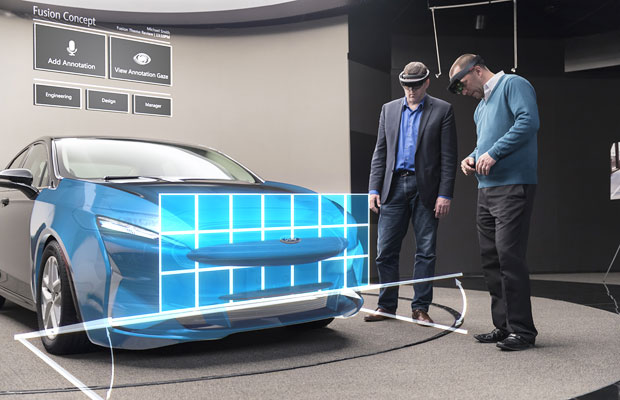Ford Motor Company on Thursday unveiled details about its use of Microsoft’s HoloLens augmented reality technology in the automotive design process. Ford’s design teams have swapped out their clay-sculpting tools — a staple of the automotive world since the 1930s when Harley Earl introduced them at General Motors — for mixed reality headsets and visualization software.
Unlike clay models, which can weigh 5,000 or more pounds, designers with HoloLens can make instant changes to side mirrors, grilles, interiors, and other vehicle elements. And they can do so without even getting their hands dirty.
Ford has been working with Microsoft’s HoloLens technology at its Dearborn, Michigan, studios for the past year. The mixed reality tech has allowed designers to consider proposed virtual design elements as if the additions were part of a physical vehicle. It has allowed engineers to see different shapes, sizes, and even textures on vehicles. These displays can be rendered in minutes or hours, whereas using clay models to evaluate the same changes would take weeks or even months.
Ford is not the only automaker to utilize HoloLens technology. Microsoft and Volvo Cars in 2015 announced a partnership that would allow buyers to stay in the physical world while being able to browse an augmented reality showroom that highlighted car customization options and even allowed potential car buyers to take part in virtual test drives.
Augmented Designs
Unlike virtual reality, in which everything the viewer sees is simulated, the HoloLens augmented or mixed reality experience lets designers see photo-quality backdrops along with other elements that merge with a physical object.
Designers wear wireless headsets that allow them to see real objects with virtual elements overlaid. The HoloLens technology, which is compatible with off-the-shelf Windows 10 computers, provides 3D holographic images. For designers, it means speeding the process. For engineers, it means visualizing the effects a design choice could have on driving conditions — such as how the placement of a side mirror might create blind spots for the driver.
The headsets can be synced so that multiple team members can view a design simultaneously, aiding the collaborative process. Team members can record audio notes as well.
“VR, and now mixed reality, has been gaining a significant amount of traction in most facets of design,” said Rob Enderle, principal analyst at the Enderle Group.
“The advantage of being able to create a seemingly life-size image you can explore and often place in real settings is reducing substantially the need for and eliminating the time to create physical models,” he told TechNewsWorld.
“You can only get so much out of plans and artists’ rendering,” Enderle added. “With MR, you can now see the object as it will exist before you create it in natural settings. You can even use simulators and then observe the car from the outside long before it is built, let alone ready for track testing.”
Commercial Applications
It would seem that virtual reality in its present state would offer more in the way of consumer applications, whereas augmented or mixed reality would serve the commercial world more effectively.
“The collaboration between Ford and Microsoft is an example of the practical application of AR in commercial settings,” suggested Kevin Krewell, principal analyst at Tirias Research.
“While many focus on consumer AR, Microsoft and companies like Epson, ODG, Meta, and others have seen a real market in commercial applications,” he told TechNewsWorld.
Mixed reality could be not only a time saver but also a cost and labor saver for designers and engineers alike.
“It has real benefits in the design process to visualize parts of the car before building clay models and sheet metal,” added Krewell.
Opportunities for Innovation
A faster design process also would allow automakers to refocus their efforts on innovation as they strive to beat rivals to the finish line — or at least to the showroom floor.
Mixed reality technology can’t yet replace all physical testing, but it can dramatically increase the pace of development efforts.
“This is critical for firms like Ford, who are trying to catch Tesla and adjust for the coming world of electric autonomous cars,” observed Enderle.
Moreover, while mixed reality might not be an entertainment technology for consumers in the way that VR promises to be, it could enhance their experiences on the showroom floor.
“From the consumer perspective, it creates better ways to configure the car because they can see a configuration even if it doesn’t exist in pictures or on the showroom floor, just by donning the VR or MR goggles,” Enderle said.
“Because this allows for more experimentation during the design process, the cars they eventually get should be more pleasing and advance more quickly,” he suggested. “This could vastly improve not only the quality of cars but also our satisfaction with them.”























































